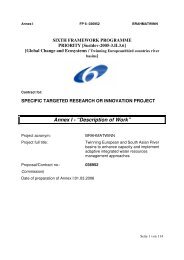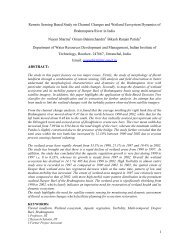WP 5 Analysis of present IWRM practices - Brahmatwinn
WP 5 Analysis of present IWRM practices - Brahmatwinn
WP 5 Analysis of present IWRM practices - Brahmatwinn
Create successful ePaper yourself
Turn your PDF publications into a flip-book with our unique Google optimized e-Paper software.
Sarpang and Gelephu were later electrified in the years 1969 to 1973 with electricity imported from<br />
the Assam State Electricity Board <strong>of</strong> India.<br />
Between 1972 to 1976, several mini hydroelectric plants were constructed through grant assistance<br />
from the Government <strong>of</strong> India at Trashigang, Wangduephodrang, Gidakom and Mongar. The<br />
construction <strong>of</strong> the Chukha Hydroelectric plant started in 1978, which was built with assistance from<br />
the Government <strong>of</strong> India. In 1988, it was fully commissioned generating 336 MW. This was a major<br />
milestone in the sustainable development <strong>of</strong> the hydroelectric sector for economic development.<br />
This led to an increase in the availability <strong>of</strong> power in the western regions <strong>of</strong> Bhutan as well as<br />
increased the government’s gross revenue from the sale <strong>of</strong> surplus power to India.<br />
During the period between 1986 to 1987, ten micro hydroelectric plants, ranging in size from 20 kW<br />
to 70 kW, were commissioned with Japanese assistance. During 1987 to 1988, two mini hydroelectric<br />
plants at Khaling (0.4 MW) and Chumey (1 MW) were commissioned with assistance from the<br />
Government <strong>of</strong> India. During 1991 to 1993, three micro hydroelectric plants <strong>of</strong> 200 kW each were<br />
commissioned in Tsirang, Dagana and Zhemgang with Japanese grant assistance. As per Power<br />
System Master Plan study that was updated in 2002, the country’s total hydropower potential has<br />
been stated as 30,000 MW, <strong>of</strong> which about 23,760 MW from 76 sites (which are above 10 MW<br />
capacity) has been identified as techno-economically feasible for development. However, the total<br />
hydropower developed as <strong>of</strong> April 2006 is only 468.698 MW which is mere 1.56 % <strong>of</strong> the total<br />
potential. Even with the full commissioning <strong>of</strong> 1020 MW Tala hydroelectric project, the total<br />
hydropower that would have been developed would remain about 1488.698 MW, about 4.96 % <strong>of</strong><br />
the total potential. Therefore, there is lot to be still done to accelerate the development <strong>of</strong><br />
hydropower potentials <strong>of</strong> the kingdom. The peak power demand and energy requirement <strong>of</strong> Bhutan<br />
during the year 2004-05 was recorded at 120 MW and 753 Million Units (MU) respectively. In 2007,<br />
the Druk Green Power Corporation was formed as an over-riding authority for the hydropower sector<br />
in Bhutan. To date, three <strong>of</strong> the four major power generation plants fall under this umbrella<br />
Corporation. The Tala Hydro-Power Authority is expected to join the Corporation in the near future.<br />
GCC adaption strategies in Bhutan<br />
There is no perceived pollution in Paro and the general perception is that there is sufficient water.<br />
However, work undertaken by school children as part <strong>of</strong> the WWMP-RSPN environmental education<br />
program identified E.Coli as a serious problem in a number <strong>of</strong> streams close by to schools, all <strong>of</strong> these<br />
related to either open defecation or pit latrines being placed too close to the stream.<br />
In terms <strong>of</strong> water supply, a number <strong>of</strong> springs have dried up in recent years in the Paro valley, and<br />
some view this as a result <strong>of</strong> the general lowering <strong>of</strong> the water table due to increased extraction for<br />
building purposes and a growing population with increased aspirations. Certainly, many new<br />
buildings, for <strong>of</strong>fices and hotels as well as private residences, have been constructed in the last<br />
decade. Another factor that may be having an impact on water use for construction and individual<br />
consumption is the increased number <strong>of</strong> hotels and tourists especially in Paro and Thimphu valleys.<br />
The daily consumption <strong>of</strong> water by a western visitor is estimated to be at least 4 times that <strong>of</strong> a<br />
national resident, through the need/desire for showers, baths, and laundry services.<br />
There are no current estimates <strong>of</strong> groundwater resources or its quality, which are assumed to be in a<br />
sound and stable condition. Only in Phuentsholing are significant amounts <strong>of</strong> ground water extracted<br />
to provide water to the urban area, and no reports exist as to these sources being stressed.<br />
26





